中西节日文化差异 英文
- 格式:docx
- 大小:12.68 KB
- 文档页数:5
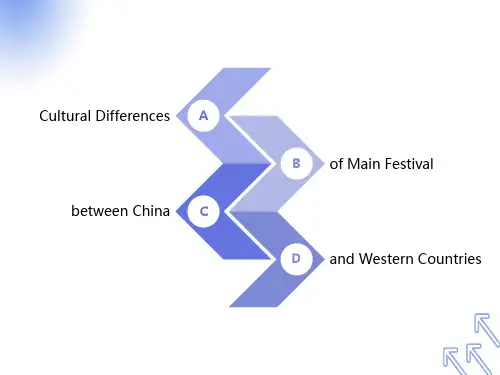
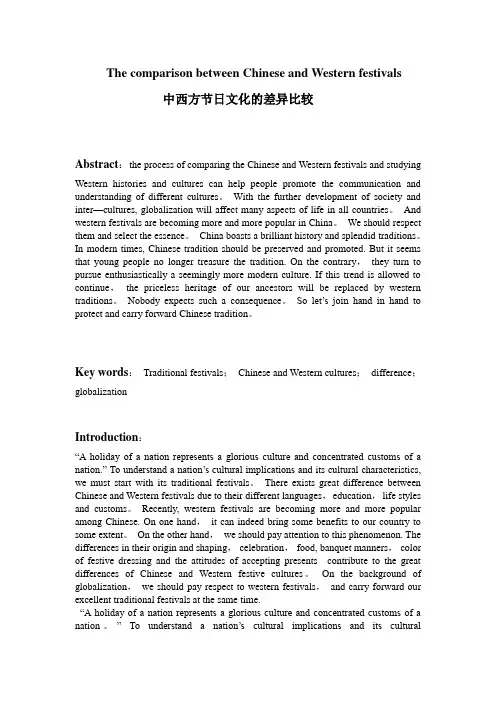
The comparison between Chinese and Western festivals中西方节日文化的差异比较Abstract:the process of comparing the Chinese and Western festivals and studying Western histories and cultures can help people promote the communication and understanding of different cultures。
With the further development of society and inter—cultures, globalization will affect many aspects of life in all countries。
And western festivals are becoming more and more popular in China。
We should respect them and select the essence。
China boasts a brilliant history and splendid traditions。
In modern times, Chinese tradition should be preserved and promoted. But it seems that young people no longer treasure the tradition. On the contrary,they turn to pursue enthusiastically a seemingly more modern culture. If this trend is allowed to continue,the priceless heritage of our ancestors will be replaced by western traditions。
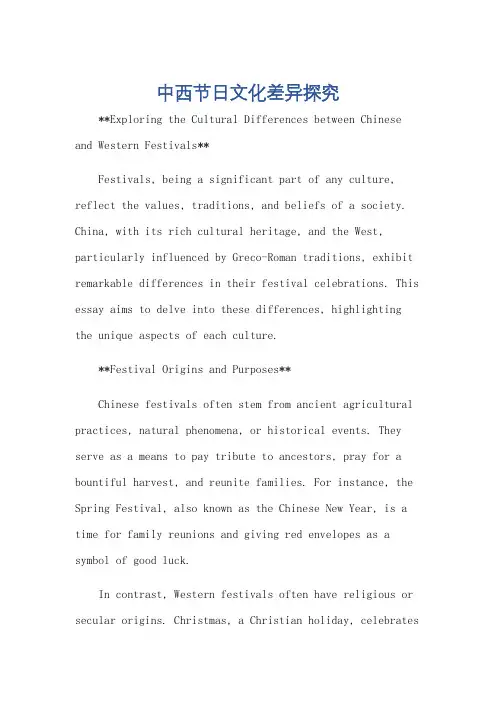
中西节日文化差异探究**Exploring the Cultural Differences between Chinese and Western Festivals**Festivals, being a significant part of any culture, reflect the values, traditions, and beliefs of a society. China, with its rich cultural heritage, and the West, particularly influenced by Greco-Roman traditions, exhibit remarkable differences in their festival celebrations. This essay aims to delve into these differences, highlighting the unique aspects of each culture.**Festival Origins and Purposes**Chinese festivals often stem from ancient agricultural practices, natural phenomena, or historical events. They serve as a means to pay tribute to ancestors, pray for a bountiful harvest, and reunite families. For instance, the Spring Festival, also known as the Chinese New Year, is a time for family reunions and giving red envelopes as a symbol of good luck.In contrast, Western festivals often have religious or secular origins. Christmas, a Christian holiday, celebratesthe birth of Jesus Christ, while Halloween, a pagan festival, marks the end of the summer and the beginning of winter. These festivals serve as a time for community gatherings, gift-giving, and celebrating life's joys.**Festival Customs and Rituals**Chinese festivals are often marked by specific customs and rituals. The Dragon Dance, a popular performance during the Spring Festival, symbolizes good luck and the defeat of evil. The Mid-Autumn Festival, on the other hand, is marked by moon gazing and the eating of mooncakes, symbolizing family unity.Western festivals, on the contrary, are often associated with specific symbols and traditions. Christmas, for instance, is marked by the exchange of gifts, the decoration of Christmas trees, and the singing of carols. Easter, another significant Western festival, involves the celebration of the resurrection of Jesus Christ, marked by egg hunts and the eating of chocolate eggs.**Festival Foods**Food plays a crucial role in both Chinese and Western festivals. Chinese festivals often feature traditional dishes that are associated with specific meanings. For instance, dumplings during the Winter Solstice symbolize family unity, while fish during the Spring Festival represents abundance.Western festivals also have their unique food traditions. Christmas, for example, is associated with turkey, ham, and various desserts such as Christmas pudding and mince pies. Easter, on the other hand, is marked by the eating of hot cross buns and chocolate eggs.**Conclusion**In conclusion, the cultural differences between Chinese and Western festivals are numerous and significant. These differences are a testament to the unique historical, religious, and cultural backgrounds of each region. Understanding and respecting these differences is crucialin promoting cultural harmony and understanding. As the world becomes increasingly globalized, it is important to recognize and celebrate the rich diversity of festival celebrations around the globe.**中西节日文化差异探究**节日作为文化的重要组成部分,反映了一个社会的价值观、传统和信仰。
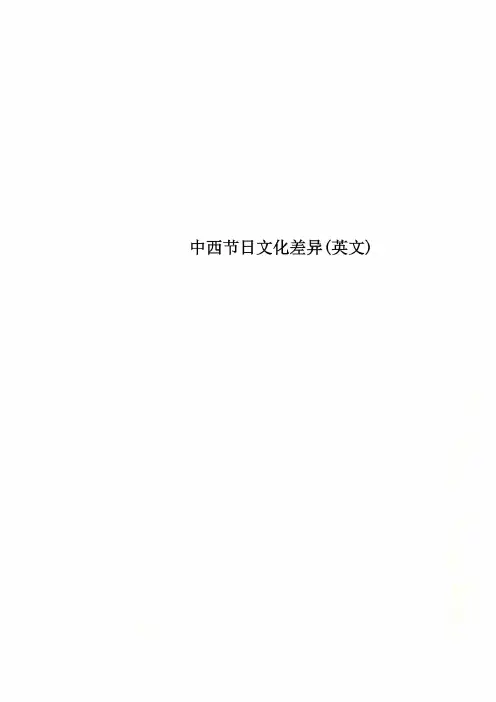
calendar. On the night of December 31, particularly close to the late zero o’clock, tens of thousands of people gather in to pray sincerely and silently for the coming year’s countdown. When the bell sounds 12, suddenly, the beautiful music sound, people are singing happily and talking cheerfully, playing all night long. In China, the Spring Festival falls on January 1st in lunar calendar since Qin Dynasty. On the eve of Spring Festival, we get together to enjoy delicious food and cuisine, staying up for the coming New Year to bid farewell to the old year. The whole family will spend a beautiful night in the sound of firecrackers. The Spring Festival lasts until Lantern Festival. Spring cleaning, New Year gathering, firecrackers, lion dance are the popular customs during Spring Festival. Each of the two festivals has its strong points: The western New Year embodies fashion trend and modern life. While Chinese people attach great importance to dense national culture and traditional atmosphere to the Spring Festival; it has the glorious history and the unique beauty.* Qingming Festival Vs Halloween DayIn China, April in the lunar year is an important month for ghosts. In this month, the souls will be released from the Hades, and people will be organized to hold activities to entertain them with their hospitality for this rare "holidays". Particularly on April 4th, Qingming festival, every family will prepare for rich offerings to sacrifice these good brothers who come from the nether world. There’re many other activities during the Qingming Festival, such as visiting their ancestors’ tombs, spring hiking and planting osier. Osier means indomitable vitality and can ward off bad luck at the same time. Visiting ancestors’ tombs in Qingming Festival can not only show their respect, what’s more, it shows people’s enthusiasm for life.In the west, the similar festival is called Halloween day(Oct.11-Nov.7th). It is the third important festival next to Christmas and Thanksgiving Day. It is said that people should let the ghost see their satisfactory harvest and present abundant sacrifice to them. Both the bonfires and lights are not only to scare the ghosts away, but also to illuminate them back to the place where they come from. On this day, people can disguise th emselves freely and make trouble to their heart’s content. On many public occasions and home compound, people lay out different kinds of decorations on the windows and doors, such as pumpkin lights, a scarecrow and even the skeleton. Every family will hold a dressing ball, and put on fruit and other crops on the table.3. the difference on foodChinese traditional food put emphasis on color, smell and taste. Nearly endless variety of natural ingredients and methods of preparations are employed in Chinese cuisine. The careful coordination of such a series of delicate activities as selecting ingredients, mixing flavors, timing the cooking, controlling the heat and finally laying out the food on the plate for the table are the typical characteristics of Chinese food, especially the festive cuisine. Each Chinese festival is characterized by their distinguished food. People in northern China eat jiaozi on the eve of Spring Festival. The Chinese character "jiao" in "jiaozi" sound like"jiao" which implies union. Besides, jiaozi resembles a gold ingot meaning the gaining of wealth. Throughout southern China, niangao(literally meaning the "year cake", a thick steamed pudding of glutinous rice flour) is made in a great variety of shapes and flavors. The character "gao" in the word "niangao" is homonymous with the word "high", suggesting "growing up and prospering in the new year". We have "yuanxiao" on Lantern Festival, glutinous rice dumplings on Dragon Boat Festival, moon-cake on Mid-autumn Festival. By contrast, the western food tends to be simplified due to their advanced food technology, such as the canned food, fast food, etc. KFC, McDonald is time-saving but lack nutrition.4.the difference of banquet mannersIn China, people will sit around in the festive banquet. We often take round table for the banquet which create friendly and united atmosphere. The food at the center of the table is not only what people eat but also the medium of exchange. People toast to each other, showing respect and courtesy of China. It reflects the influence of "he" in Chinese classic philosophy on off-springs, round table is good for group communication.In western festive banquet, food and drinks just serve as dressing while communication is the core of the banquet. If compared to dance, Chinese banquet is group dancing, western's is social dancing. The purpose of communication on Chinese and western festive banquet is obvious. Chinese festive banquet focus on the communication among all the people presented. While the western banquet emphasizes on personal communication.5. the difference in color of festive dressingThe implications of colors -----The same color symbolizes different meanings in Chinese and western festive cultures.RedRed is a typical color in China. Red lanterns are lit, red couplets and "fu" are put up during festivals. It symbolizes beauty and luck, so red is the first choice of festivals. But in western culture, red is a derogatory term which reminds flood and violence.WhiteWhite is taboo in Chinese festivals which is often used in funerals while in the west, white is a typical festive color. It symbolizes purity and elegance, such as the wedding dress, white candles during the festivals.YellowYellow means dignity in China. In ancient times, only the royal members can be allowed to yellow dress. It has been the color for the ancient China. While in western culture, the color yellow has some negative meanings, it mainly means despicable, timid (for example, yellow dog----despicable people, yellow-livered, yellow streak).6. the difference in the habit of accepting presentsChinese veil their real thoughts while Westerners always reveal their mindsfreely and directly. The way of accepting gifts and the attitudes are different. During festivals, the Chinese and the Western countries have shown very different attitudes about a gift for someone. In western country, people often ask for a gift, and they will usually open it in front of people’s face and express their thanks. Chinese people often defer about the present since we are guided by the tradition of modest and courtesy. And we usually do not open it in front of the presenter.In addition, China is a multi-ethnic country. Different lifestyles and customs of different nations contribute to the diversifications and characteristics of Chinese culture. Many minorities have their local festivals, such as the Sporangia Festival of Daizu, Torch Festival of Yizu, etc.Conclusion:In modern times, the prevalence of western festivals in China is the feature of globalization and the mixture of multi-culture. We should pay respect to western festivals, but on the other side, we Chinese should safeguard and protect our own cultural spirit and explore new implication to accomplish the lofty cause of transiting and inheriting our national culture. In fact, what the traditional festivals contain is the traditional culture, which is the national spirit that combines the national confidence and national pride. So the government has the responsibility to strengthen the education to make more people, particularly the young, better know and like our own traditional culture, thus building up national confidence and national pride to carry forward the Chinese excellent traditions.。
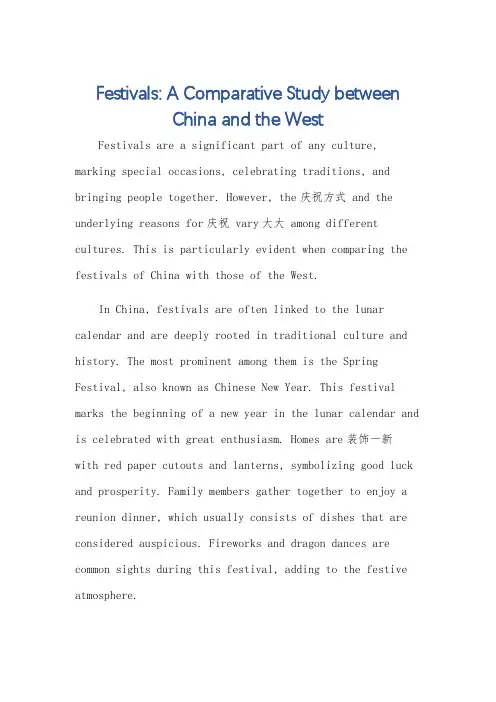
Festivals: A Comparative Study betweenChina and the WestFestivals are a significant part of any culture, marking special occasions, celebrating traditions, and bringing people together. However, the庆祝方式 and the underlying reasons for庆祝 vary大大 among different cultures. This is particularly evident when comparing the festivals of China with those of the West.In China, festivals are often linked to the lunar calendar and are deeply rooted in traditional culture and history. The most prominent among them is the Spring Festival, also known as Chinese New Year. This festival marks the beginning of a new year in the lunar calendar and is celebrated with great enthusiasm. Homes are装饰一新with red paper cutouts and lanterns, symbolizing good luck and prosperity. Family members gather together to enjoy a reunion dinner, which usually consists of dishes that are considered auspicious. Fireworks and dragon dances are common sights during this festival, adding to the festive atmosphere.Contrastingly, Western festivals often have a more religious or historical background. Christmas, for instance, is the most significant festival in the Western world. It commemorates the birth of Jesus Christ and is marked with a variety of traditions such as caroling, gift-giving, and feasting. The iconic Christmas tree and the brightly lit displays are symbols of the festival, creating a warm and festive atmosphere.Another significant Western festival is Easter, which commemorates the resurrection of Jesus Christ. Thisfestival is marked with egg hunts, chocolate giving, and religious services. In contrast, the Dragon Boat Festivalin China, which marks the anniversary of a famous ancient poet's death, is celebrated with dragon boat races and the eating of zongzi, a type of rice dumpling.The differences between Chinese and Western festivals extend beyond their historical and religious backgrounds. Chinese festivals tend to emphasize family reunions and the importance of maintaining harmonious relationships with others. By contrast, Western festivals often highlight theindividual and the importance of giving and receiving love and affection.The differences in庆祝方式 between Chinese and Western festivals are also noteworthy. Chinese festivals often involve elaborate food preparations, such as the various dumplings and cakes associated with different festivals. These foods are not just meals but also symbols of goodluck and prosperity. In contrast, Western festivals often center around gift-giving, with people exchanging presents as a way of showing affection and appreciation.Moreover, the role of technology and social media in庆祝西方节日 has become increasingly significant in recent years. People use these platforms to share their celebrations, post photos, and connect with others far away. This aspect is less prominent in Chinese festivals, where the focus tends to be more on personal and family-oriented庆祝方式.Despite these differences, there are also similarities between Chinese and Western festivals. Both celebrate joy, love, and unity in their own unique ways. Both involve gatherings of family and friends, sharing of food, andparticipation in specific activities that are significant to the festival.In conclusion, the festivals of China and the West, though different in many ways, reflect the rich diversity of human culture and tradition. They are a testament to the unique values and beliefs of each culture and serve as a bridge between generations, binding people together through shared experiences and memories. It is this diversity that makes the world such a vibrant and interesting place tolive in.。
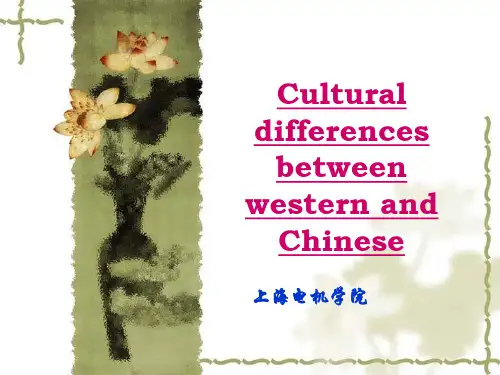
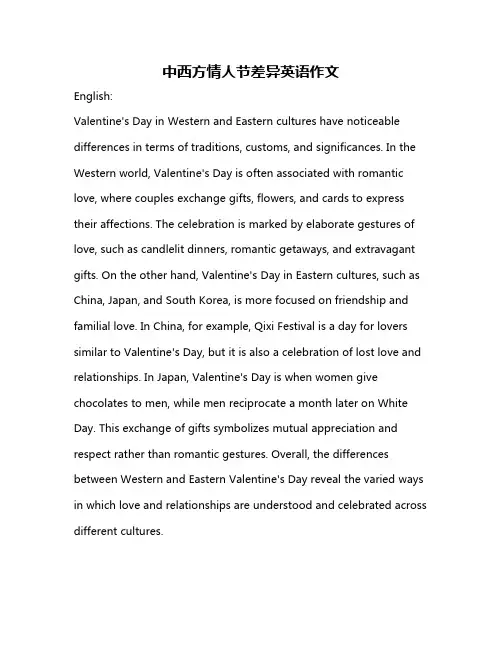
中西方情人节差异英语作文English:Valentine's Day in Western and Eastern cultures have noticeable differences in terms of traditions, customs, and significances. In the Western world, Valentine's Day is often associated with romantic love, where couples exchange gifts, flowers, and cards to express their affections. The celebration is marked by elaborate gestures of love, such as candlelit dinners, romantic getaways, and extravagant gifts. On the other hand, Valentine's Day in Eastern cultures, such as China, Japan, and South Korea, is more focused on friendship and familial love. In China, for example, Qixi Festival is a day for lovers similar to Valentine's Day, but it is also a celebration of lost love and relationships. In Japan, Valentine's Day is when women give chocolates to men, while men reciprocate a month later on White Day. This exchange of gifts symbolizes mutual appreciation and respect rather than romantic gestures. Overall, the differences between Western and Eastern Valentine's Day reveal the varied ways in which love and relationships are understood and celebrated across different cultures.中文翻译:西方和东方文化中的情人节在传统、习俗和意义上有明显的差异。

The comparison between Chinese and Western festivals中西方节日文化的差异比较Abstract: the process of comparing the Chinese and Western festivals and studying Western histories and cultures can help people promote the communication and understanding of different cultures. With the further development of society and inter-cultures, globalization will affect many aspects of life in all countries. And western festivals are becoming more and more popular in China. We should respect them and select the essence. China boasts a brilliant history and splendid traditions. In modern times, Chinese tradition should be preserved and promoted. But it seems that young people no longer treasure the tradition. On the contrary, they turn to pursue enthusiastically a seemingly more modern culture. If this trend is allowed to continue, the priceless heritage of our ancestors will be replaced by western traditions. Nobody expects such a consequence. So let’s join hand in hand to protect and carry forward Chinese tradition.Key words: Traditional festivals; Chinese and Western cultures; difference; globalizationIntroduction:“A holiday of a nation represents a glorious culture and concentrated customs of a nation.” To understand a nation's cultural implications a nd its cultural characteristics, we must start with its traditional festivals. There exists great difference between Chinese and Western festivals due to their different languages, education, life styles and customs. Recently, western festivals are becoming more and more popular among Chinese. On one hand, it can indeed bring some benefits to our country to some extent. On the other hand, we should pay attention to this phenomenon. The differences in their origin and shaping, celebration, food, banquet manners, color of festive dressing and the attitudes of accepting presents contribute to the great differences of Chinese and Western festive cultures. On the background of globalization, we should pay respect to western festivals, and carry forward our excellent traditional festivals at the same time.“A holiday of a nation represents a glorious culture and concentrated customs of a nation.” To understand a nation's cultural implications and its cultural characteristics,we must start with its traditional festivals. There exists great difference between the Chinese and Western festivals due to their different languages, education, life styles and customs.Recently, western festivals are becoming more and more popular among Chinese people, especially among the young. According to an internet survey, more than half of the thirties prefer foreign festivals.With the further development of society and inter-culture, though we should not reject the advanced technology, culture, and foreign language, there is a touch of melancholy when coming to think that our traditional festivals was neglected.There are several possible reasons for this phenomenon. First, western nations, such as the United States and Britain, are powerful and dominant in many aspects. Everything in these countries is assumed to be superior and adored by some modern young people. Second, the prevalence of English as a world language and the development of globalization enable western culture to flood in China. Overwhelmed by such a trend, Chinese unconsciously get involved in western culture. Last but not least, some Chinese people have blind faith in foreign things while dismiss our own possessions with contempt. Undoubtedly, enjoying western festivals can enrich our life, bring us more happiness, promote communication and enhance our friendship. Whether be the foreign festivals or traditional festivals, they all imply the meaning of union, safety and blessing. From the perspective of consumption and entertainment, festivals can not only stimulate domestic demand, but also provide access to exotic cultures. And foreign festival, to some extent, means peer-gathering.Besides, more people should make careful analysis of the differences between Chinese and foreign festival cultures.1. the difference of where they originated and how they took shapeThe original meaning of Chinese traditional festivals is from agriculture, because our country had been in feudal self-sufficient agricultural society and natural economy for a long time. As the old saying goes "Rain in spring is as precious as oil" "The peasants are busy with growing wheat during the Qingming festival". The Spring Festival and Qingming have been important agricultural festivals since ancient times. Western traditional festivals originated from Christianity, such as St. Valentine's Day is in commemoration of Christianity martyr named Valentine, and the Easter of the revival of Jesus, Halloween is All Saints’ Day, and the Christmas is the birth of Jesus.2. the difference in celebrationWestern traditional festivals emphasize on interactivity, collectivity and extreme carnival, focusing on self and advocating free expressing of personality. While in China, we focus on family reunion and enjoy happy family relations. Here we set two examples as follows.*Spring Festival Vs New YearIn western nations, the New Year’s Day falls on January 1st in Gregorian calendar. On the night of December 31, particularly close to the late zero o’clock, tens of thousands of people gather in to pray sincerely and silently for the coming year’s countdown. When the bell sounds 12, suddenly, the beautiful music sound, people are singing happily and talking cheerfully, playing all night long. In China, the Spring Festival falls on January 1st in lunar calendar since Qin Dynasty. On the eve of Spring Festival, we get together to enjoy delicious food and cuisine, staying up for the coming NewYear to bid farewell to the old year. The whole family will spend a beautiful night in the sound of firecrackers. The Spring Festival lasts until Lantern Festival. Spring cleaning, New Year gathering, firecrackers, lion dance are the popular customs during Spring Festival. Each of the two festivals has its strong points: The western New Year embodies fashion trend and modern life. While Chinese people attach great importance to dense national culture and traditional atmosphere to the Spring Festival; it has the glorious history and the unique beauty.* Qingming Festival Vs Halloween DayIn China, April in the lunar year is an important month for ghosts. In this month, the souls will be released from the Hades, and people will be organized to hold activities to entertain them with their hospitality for this rare "holidays". Particularly on April 4th, Qingming festival, every family will prepare for rich offerings to sacrifice these good brothers who come from the nether world. There’re many other activities during the Qingming Festival, such as visiting their ancestors’ tombs, spring hiking and planting osier. Osier means indomitable vitality and can ward off bad luck at the same time. Visiting ancestors’ tombs in Qingming Festival can not only show their respect, what’s more, it shows people’s enthusiasm for life.In the west, the similar festival is called Halloween day(Oct.11-Nov.7th). It is the third important festival next to Christmas and Thanksgiving Day. It is said that people should let the ghost see their satisfactory harvest and present abundant sacrifice to them. Both the bonfires and lights are not only to scare the ghosts away, but also to illuminate them back to the place where they come from. On this day, people can disguise themselves freely and make trouble to their heart’s content. On many public occasions and home compound, people lay out different kinds of decorations on the windows and doors, such as pumpkin lights, a scarecrow and even the skeleton. Every family will hold a dressing ball, and put on fruit and other crops on the table.3. the difference on foodChinese traditional food put emphasis on color, smell and taste. Nearly endless variety of natural ingredients and methods of preparations are employed in Chinese cuisine. The careful coordination of such a series of delicate activities as selecting ingredients, mixing flavors, timing the cooking, controlling the heat and finally laying out the food on the plate for the table are the typical characteristics of Chinese food, especially the festive cuisine. Each Chinese festival is characterized by their distinguished food. People in northern China eat jiaozi on the eve of Spring Festival. The Chinese character "jiao" in "jiaozi" sound like "jiao" which implies union. Besides, jiaozi resembles a gold ingot meaning the gaining of wealth. Throughout southern China, niangao(literally meaning the "year cake", a thick steamed pudding of glutinous rice flour) is made in a great variety of shapes and flavors. The character "gao" in the word "niangao" is homonymous with the word "high", suggesting "growing up and prospering in the new year". We have "yuanxiao" on Lantern Festival, glutinous rice dumplings on Dragon Boat Festival, moon-cake on Mid-autumn Festival. By contrast, the western food tends to be simplified due to their advanced food technology, such as the canned food, fast food, etc. KFC, McDonald is time-saving but lack nutrition.4.the difference of banquet mannersIn China, people will sit around in the festive banquet. We often take round table for the banquet which create friendly and united atmosphere. The food at the center of the table is not only what people eat but also the medium of exchange. People toast to each other, showing respect and courtesy of China. It reflects the influence of "he" in Chinese classic philosophy on off-springs, round table is good for group communication.In western festive banquet, food and drinks just serve as dressing while communication is the core of the banquet. If compared to dance, Chinese banquet is group dancing, western's is social dancing. The purpose of communication on Chinese and western festive banquet is obvious. Chinese festive banquet focus on the communication among all the people presented. While the western banquet emphasizes on personal communication.5. the difference in color of festive dressingThe implications of colors -----The same color symbolizes different meanings in Chinese and western festive cultures.RedRed is a typical color in China. Red lanterns are lit, red couplets and "fu" are put up during festivals. It symbolizes beauty and luck, so red is the first choice of festivals. But in western culture, red is a derogatory term which reminds flood and violence. WhiteWhite is taboo in Chinese festivals which is often used in funerals while in the west, white is a typical festive color. It symbolizes purity and elegance, such as the wedding dress, white candles during the festivals.YellowYellow means dignity in China. In ancient times, only the royal members can be allowed to yellow dress. It has been the color for the ancient China. While in western culture, the color yellow has some negative meanings, it mainly means despicable, timid (for example, yellow dog----despicable people, yellow-livered, yellow streak). 6. the difference in the habit of accepting presentsChinese veil their real thoughts while Westerners always reveal their minds freely and directly. The way of accepting gifts and the attitudes are different. During festivals, the Chinese and the Western countries have shown very different attitudes about a gift for someone. In western country, people often ask for a gift, and they will usually open it in front of people’s face and express their thanks. Chinese people often defer about the present since we are guided by the tradition of modest and courtesy. And we usually do not open it in front of the presenter.In addition, China is a multi-ethnic country. Different lifestyles and customs of different nations contribute to the diversifications and characteristics of Chinese culture. Many minorities have their local festivals, such as the Sporangia Festival of Daizu, Torch Festival of Yizu, etc.Conclusion:In modern times, the prevalence of western festivals in China is the feature of globalization and the mixture of multi-culture. We should pay respect to western festivals, but on the other side, we Chinese should safeguard and protect our own cultural spirit and explore new implication to accomplish the lofty cause of transiting and inheriting our national culture. In fact, what the traditional festivals contain is the traditional culture, which is the national spirit that combines the national confidence and national pride. So the government has the responsibility to strengthen the education to make more people, particularly the young, better know and like our own traditional culture, thus building up national confidence and national pride to carry forward the Chinese excellent traditions.。
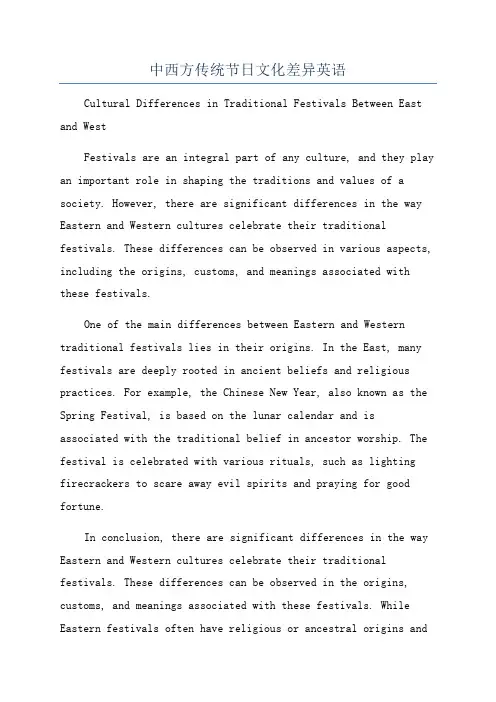
中西方传统节日文化差异英语Cultural Differences in Traditional Festivals Between East and WestFestivals are an integral part of any culture, and they play an important role in shaping the traditions and values of a society. However, there are significant differences in the way Eastern and Western cultures celebrate their traditional festivals. These differences can be observed in various aspects, including the origins, customs, and meanings associated with these festivals.One of the main differences between Eastern and Western traditional festivals lies in their origins. In the East, many festivals are deeply rooted in ancient beliefs and religious practices. For example, the Chinese New Year, also known as the Spring Festival, is based on the lunar calendar and is associated with the traditional belief in ancestor worship. The festival is celebrated with various rituals, such as lighting firecrackers to scare away evil spirits and praying for good fortune.In conclusion, there are significant differences in the way Eastern and Western cultures celebrate their traditional festivals. These differences can be observed in the origins, customs, and meanings associated with these festivals. While Eastern festivals often have religious or ancestral origins andare marked by elaborate ceremonies and rituals, Western festivals are more festive and celebratory in nature and often have personal meanings. These cultural differences reflect the unique values, beliefs, and traditions of each society and contribute to the richness and diversity of human culture as a whole.。
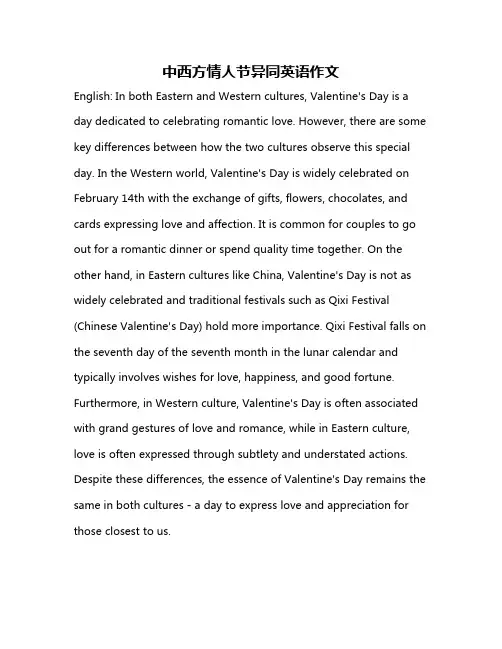
中西方情人节异同英语作文English: In both Eastern and Western cultures, Valentine's Day is a day dedicated to celebrating romantic love. However, there are some key differences between how the two cultures observe this special day. In the Western world, Valentine's Day is widely celebrated on February 14th with the exchange of gifts, flowers, chocolates, and cards expressing love and affection. It is common for couples to go out for a romantic dinner or spend quality time together. On the other hand, in Eastern cultures like China, Valentine's Day is not as widely celebrated and traditional festivals such as Qixi Festival (Chinese Valentine's Day) hold more importance. Qixi Festival falls on the seventh day of the seventh month in the lunar calendar and typically involves wishes for love, happiness, and good fortune. Furthermore, in Western culture, Valentine's Day is often associated with grand gestures of love and romance, while in Eastern culture, love is often expressed through subtlety and understated actions. Despite these differences, the essence of Valentine's Day remains the same in both cultures - a day to express love and appreciation for those closest to us.中文翻译: 在东西方文化中,情人节都是一个专注于庆祝浪漫爱情的日子。
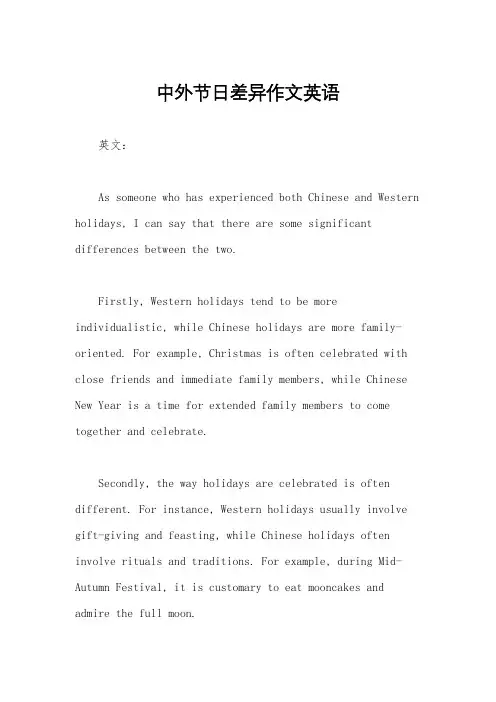
中外节日差异作文英语英文:As someone who has experienced both Chinese and Western holidays, I can say that there are some significant differences between the two.Firstly, Western holidays tend to be more individualistic, while Chinese holidays are more family-oriented. For example, Christmas is often celebrated with close friends and immediate family members, while Chinese New Year is a time for extended family members to come together and celebrate.Secondly, the way holidays are celebrated is often different. For instance, Western holidays usually involve gift-giving and feasting, while Chinese holidays often involve rituals and traditions. For example, during Mid-Autumn Festival, it is customary to eat mooncakes and admire the full moon.Lastly, the meaning behind the holidays can also differ. Western holidays often have religious or historical significance, while Chinese holidays are often tied to the lunar calendar and agricultural traditions. For example, Thanksgiving in the US is a time to give thanks for the blessings of the year and the harvest, while the DragonBoat Festival in China is a time to commemorate the deathof a patriotic poet.中文:作为一个经历过中国和西方节日的人,我可以说这两者之间有一些显著的差异。
中英节日对比总结英语作文英文:As an international student studying in the UK, I have had the opportunity to experience and compare both Chinese and English festivals. There are many differences between the two cultures when it comes to celebrating festivals.Firstly, Chinese festivals are often based on the lunar calendar, while English festivals are based on the Gregorian calendar. For example, Chinese New Year, also known as the Spring Festival, falls on the first day of the first lunar month, usually in late January or early February. On the other hand, Christmas in the UK is celebrated on December 25th every year.Secondly, the way people celebrate festivals in the two cultures is also quite different. During Chinese New Year, families gather for a reunion dinner on New Year's Eve, and people often set off firecrackers to ward off evil spirits.In the UK, Christmas is a time for families to exchange gifts, decorate Christmas trees, and have a traditional roast dinner together.Furthermore, the significance and customs of the festivals vary greatly. For example, during the Mid-Autumn Festival in China, people eat mooncakes and appreciate the full moon, while in the UK, Halloween is a time for dressing up in costumes, carving pumpkins, and going trick-or-treating.In addition, the traditional food and drinks associated with the festivals are also different. For example, during Chinese New Year, it is customary to eat dumplings, fish, and tangyuan (sweet rice balls), while in the UK, people enjoy roast turkey, mince pies, and mulled wine during Christmas.中文:作为一名在英国留学的国际学生,我有机会体验并比较中英两国的节日。
中西节日对比英语作文120字英文回答:Chinese and Western festivals are two differentcultural traditions that have evolved over centuries. While they share some similarities, there are also many differences between them.One of the most obvious differences between Chinese and Western festivals is the way they are celebrated. Chinese festivals are typically celebrated with large feasts, fireworks, and other traditional activities. Western festivals, on the other hand, are often more focused on family gatherings and religious observances.Another difference between Chinese and Westernfestivals is the time of year in which they are celebrated. Chinese festivals are typically celebrated according to the lunar calendar, which means that they fall on different dates each year. Western festivals, on the other hand, aretypically celebrated according to the Gregorian calendar, which means that they fall on the same dates each year.Finally, Chinese and Western festivals have different origins. Chinese festivals are often rooted in ancient Chinese mythology and tradition, while Western festivalsare often rooted in Christian or other religious traditions.中文回答:中文回答:中国和西方节日是历经数个世纪发展演变而来的两种不同的文化传统。
东西方情人节差异英文作文英文:Valentine's Day is a special day for lovers all overthe world, but there are some differences in how it is celebrated in the East and the West.In the West, Valentine's Day is usually celebrated on February 14th, and it is a day for couples to express their love for each other. It is common for people to exchange gifts, such as chocolates, flowers, and cards. Some couples also go out for a romantic dinner or plan a weekend getaway.In the East, there are different variations ofValentine's Day. In Japan, for example, there are two Valentine's Days: one on February 14th, which is similar to the Western Valentine's Day, and another on March 14th, called White Day, where men are expected to return thefavor and give gifts to women who gave them gifts on Valentine's Day. In China, there is a similar holidaycalled Qixi Festival, also known as Chinese Valentine's Day, which falls on the 7th day of the 7th lunar month. It is a day for couples to show their love for each other, and itis common for people to exchange gifts and go out for a romantic date.Overall, while Valentine's Day is a day for expressing love and affection in both the East and the West, there are some cultural differences in how it is celebrated.中文:情人节是全世界情侣们共同的节日,但在东西方的庆祝方式上有所不同。
OECD says Unemployment Will Continue to RiseOECD:工业化国家失业率持续攀升Despite reports that many industrialized economies are beginning to emerge from their worst economic crisis in decades, unemployment is rising and will likely reach a historic peak of nearly 10 percent next year. The findings come from the Organization for Economic Cooperation and Development in Paris.经济合作与发展组织星期三报告说,工业化国家的失业率仍在增加,而且有可能在明年达到近10%的历史最高水平,尽管不断有报道说,很多工业化国家正在走出几十年来最严重的经济危机。
Indications that unemployment continues to rise is grim news for leaders heading to the G-20 summit in the United States next week. The Paris-based Organization for Economic Cooperation and Development reports unemployment reached its highest level among industrialized nations of 8.5 percent in July.对于下个星期到美国出席20国集团峰会的各国领导人来说,失业率继续上升真是个坏消息。
总部设在巴黎的经合组织说,工业化国家的失业率已经在今年7月份达到8.5%的最高水平。
中外节日对比的英文作文英文回答:A multitude of captivating festivals and holidays are celebrated globally, each steeped in its unique cultural heritage and vibrant traditions. These events provide a kaleidoscope of colors, flavors, and experiences that enchant people from all walks of life. While some festivals are observed by only a few regions or communities, others have transcended borders, becoming beloved celebrations shared across continents.One of the most widely renowned festivals is the Chinese New Year, also known as the Spring Festival. This auspicious occasion marks the beginning of a new lunar year and is celebrated with great fervor in China and many other Asian countries. Families gather for sumptuous feasts, exchange gifts, and engage in traditional activities such as lion dances and firecracker displays.In contrast, the Western New Year, celebrated onJanuary 1st, is characterized by a different set of traditions. This holiday is often associated with resolutions, fireworks, and parties. While it is primarily observed in Western countries, its influence has spread to other parts of the world.Another popular festival is Diwali, the Indian festival of lights. This five-day celebration symbolizes the triumph of good over evil and is marked by the lighting ofcountless lamps and candles. The streets are adorned with colorful decorations, and families gather to feast and exchange sweets.Halloween, celebrated on October 31st, is a Western festival that has gained immense popularity worldwide. This spooky holiday is associated with costumes, pumpkin carving, and trick-or-treating. Children and adults alike dress upin various guises, from ghouls and witches to superheroes and pop culture characters.Thanksgiving, observed primarily in the United States,is a time for gratitude and family gatherings. This autumnal holiday is celebrated with a traditional feastthat typically includes roast turkey, stuffing, and pumpkin pie. Thanksgiving serves as a reminder to reflect on the blessings in life and to appreciate the support of loved ones.While each festival holds its own distinct significance and charm, there are also notable similarities among them. Many festivals mark important astronomical events, such as the winter solstice or the arrival of spring. They also often involve rituals and traditions that have been passed down through generations, providing a sense of continuity and cultural identity.Despite their differences, festivals and holidays around the world share a common purpose: to bring people together and to celebrate life's milestones. They are a vibrant expression of human creativity and diversity, offering glimpses into the rich cultural tapestry that connects us all.中文回答:在世界各地有许多迷人的节日,每一个节日都沉浸在其独特的文化遗产和充满活力的传统中。
The comparison between Chinese and Western festivals中西方节日文化的差异比较Abstract: the process of comparing the Chinese and Western festivals and studying Western histories and cultures can help people promote the communication and understanding of different cultures. With the further development of society and inter-cultures, globalization will affect many aspects of life in all countries. And western festivals are becoming more and more popular in China. We should respect them and select the essence. China boasts a brilliant history and splendid traditions. In modern times, Chinese tradition should be preserved and promoted. But it seems that young people no longer treasure the tradition. On the contrary, they turn to pursue enthusiastically a seemingly more modern culture. If this trend is allowed to continue, the priceless heritage of our ancestors will be replaced by western traditions. Nobody expects such a consequence. So let’s join hand in hand to protect and carry forward Chinese tradition.Key words: Traditional festivals; Chinese and Western cultures; difference; globalizationIntroduction:“A holiday of a nation represents a glorious culture and concentrated customs of a nation.” To understand a nation's cultural implicat ions and its cultural characteristics, we must start with its traditional festivals. There exists great difference between Chinese and Western festivals due to their different languages, education, life styles and customs. Recently, western festivals are becoming more and more popular among Chinese. On one hand, it can indeed bring some benefits to our country to some extent. On the other hand, we should pay attention to this phenomenon. The differences in their origin and shaping, celebration, food, banquet manners, color of festive dressing and the attitudes of accepting presents contribute to the great differences of Chinese and Western festive cultures. On the background of globalization, we should pay respect to western festivals, and carry forward our excellent traditional festivals at the same time.“A holiday of a nation represents a glorious culture and concentrated customs of a nation.” To understand a nation's cultural implications and its cultural characteristics,we must start with its traditional festivals. There exists great difference between the Chinese and Western festivals due to their different languages, education, life styles and , western festivals are becoming more and more popular among Chinese people, especially among the young. According to an internet survey, more than half of the thirties prefer foreign the further development of society and inter-culture, though we should not reject the advanced technology, culture, and foreign language, there is a touch of melancholy when coming to think that our traditional festivals was are several possible reasons for this phenomenon. First, western nations, such as the United States and Britain, are powerful and dominant in many aspects. Everything in these countries is assumed to be superior and adored by some modern young people. Second, the prevalence of English as a world language and the development of globalization enable western culture to flood in China. Overwhelmed by such a trend, Chinese unconsciously get involved in western culture. Last but not least, some Chinese people have blind faith in foreign things while dismiss our own possessions with contempt. Undoubtedly, enjoying western festivals can enrich our life, bring us more happiness, promote communication and enhance our friendship. Whether be the foreign festivals or traditional festivals, they all imply the meaning of union, safety and blessing. From the perspective of consumption and entertainment, festivals can not only stimulate domestic demand, but also provide access to exotic cultures. And foreign festival, to some extent, means , more people should make careful analysis of the differences between Chinese and foreign festival cultures.1. the difference of where they originated and how they took shapeThe original meaning of Chinese traditional festivals is from agriculture, because our country had been in feudal self-sufficient agricultural society and natural economy for a long time. As the old saying goes "Rain in spring is as precious as oil" "The peasants are busy with growing wheat during the Qingming festival". The Spring Festival and Qingming have been important agricultural festivals since ancient times. Western traditional festivals originated from Christianity, such as St. Valentine's Day is in commemoration of Christianity martyr named Valentine, and the Easter of the revival of Jesus, Halloween is All Saints’ Day, and the Christmas is the birth of Jesus.2. the difference in celebrationWestern traditional festivals emphasize on interactivity, collectivity and extreme carnival, focusing on self and advocating free expressing of personality. While in China, we focus on family reunion and enjoy happy family relations. Here we set two examples as follows.*Spring Festival Vs New YearIn western nations, the New Ye ar’s Day falls on January 1st in Gregorian calendar. On the night of December 31, particularly close to the late zero o’clock, tens of thousands of people gather in to pray sincerely and silently for the coming year’s countdown. When the bell sounds 12, suddenly, the beautiful music sound, people are singing happily and talking cheerfully, playing all night long. In China, the Spring Festival falls on January 1st in lunar calendar since Qin Dynasty. On the eve of Spring Festival, we get together to enjoy delicious food and cuisine, staying up for the coming New Year to bid farewell to the old year. The whole family will spend a beautiful night inthe sound of firecrackers. The Spring Festival lasts until Lantern Festival. Spring cleaning, New Year gathering, firecrackers, lion dance are the popular customs during Spring Festival. Each of the two festivals has its strong points: The western New Year embodies fashion trend and modern life. While Chinese people attach great importance to dense national culture and traditional atmosphere to the Spring Festival; it has the glorious history and the unique beauty.* Qingming Festival Vs Halloween DayIn China, April in the lunar year is an important month for ghosts. In this month, the souls will be released from the Hades, and people will be organized to hold activities to entertain them with their hospitality for this rare "holidays". Particularly on April 4th, Qingming festival, every family will prepare for rich offerings to sacrifice these good brothers who come from the nether world. There’re many other activities during the Qingming Festival, such as visiting their ancestors’ tombs, spring hiking and planting osier. Osier means indomitable vitality and can ward off bad luck at the same time. Visiting ancestors’ tombs in Qingming Festival can not only show their respect, what’s more, it shows people’s enthusiasm for life.In the west, the similar festival is called Halloween day It is the third important festival next to Christmas and Thanksgiving Day. It is said that people should let the ghost see their satisfactory harvest and present abundant sacrifice to them. Both the bonfires and lights are not only to scare the ghosts away, but also to illuminate them back to the place where they come from. On this day, people can disguise themselves freely and make trouble to their heart’s content. On many public occasions and home compound, people lay out different kinds of decorations on the windows and doors, such as pumpkin lights, a scarecrow and even the skeleton. Every family will hold a dressing ball, and put on fruit and other crops on the table.3. the difference on foodChinese traditional food put emphasis on color, smell and taste. Nearly endless variety of natural ingredients and methods of preparations are employed in Chinese cuisine. The careful coordination of such a series of delicate activities as selecting ingredients, mixing flavors, timing the cooking, controlling the heat and finally laying out the food on the plate for the table are the typical characteristics of Chinese food, especially the festive cuisine. Each Chinese festival is characterized by their distinguished food. People in northern China eat jiaozi on the eve of Spring Festival. The Chinese character "jiao" in "jiaozi" sound like "jiao" which implies union. Besides, jiaozi resembles a gold ingot meaning the gaining of wealth. Throughout southern China, niangao(literally meaning the "year cake", a thick steamed pudding of glutinous rice flour) is made in a great variety of shapes and flavors. The character "gao" in the word "niangao" is homonymous with the word "high", suggesting "growing up and prospering in the new year". We have "yuanxiao" on Lantern Festival, glutinous rice dumplings on Dragon Boat Festival, moon-cake on Mid-autumn Festival. By contrast, the western food tends to be simplified due to their advanced food technology, such as the canned food, fast food, etc. KFC, McDonald is time-saving but lack nutrition. difference of banquet mannersIn China, people will sit around in the festive banquet. We often take round table forthe banquet which create friendly and united atmosphere. The food at the center of the table is not only what people eat but also the medium of exchange. People toast to each other, showing respect and courtesy of China. It reflects the influence of "he" in Chinese classic philosophy on off-springs, round table is good for group communication.In western festive banquet, food and drinks just serve as dressing while communication is the core of the banquet. If compared to dance, Chinese banquet is group dancing, western's is social dancing. The purpose of communication on Chinese and western festive banquet is obvious. Chinese festive banquet focus on the communication among all the people presented. While the western banquet emphasizes on personal communication.5. the difference in color of festive dressingThe implications of colors -----The same color symbolizes different meanings in Chinese and western festive cultures.RedRed is a typical color in China. Red lanterns are lit, red couplets and "fu" are put up during festivals. It symbolizes beauty and luck, so red is the first choice of festivals. But in western culture, red is a derogatory term which reminds flood and violence. WhiteWhite is taboo in Chinese festivals which is often used in funerals while in the west, white is a typical festive color. It symbolizes purity and elegance, such as the wedding dress, white candles during the festivals.YellowYellow means dignity in China. In ancient times, only the royal members can be allowed to yellow dress. It has been the color for the ancient China. While in western culture, the color yellow has some negative meanings, it mainly means despicable, timid (for example, yellow dog----despicable people, yellow-livered, yellow streak). 6. the difference in the habit of accepting presentsChinese veil their real thoughts while Westerners always reveal their minds freely and directly. The way of accepting gifts and the attitudes are different. During festivals, the Chinese and the Western countries have shown very different attitudes about a gift for someone. In western country, people often ask for a gift, and they will usually open it in front of people’s face and express their thanks. Chi nese people often defer about the present since we are guided by the tradition of modest and courtesy. And we usually do not open it in front of the presenter.In addition, China is a multi-ethnic country. Different lifestyles and customs of different nations contribute to the diversifications and characteristics of Chinese culture. Many minorities have their local festivals, such as the Sporangia Festival of Daizu, Torch Festival of Yizu, etc.Conclusion:In modern times, the prevalence of western festivals in China is the feature of globalization and the mixture of multi-culture. We should pay respect to western festivals, but on the other side, we Chinese should safeguard and protect our own cultural spirit and explore new implication to accomplish the lofty cause of transiting and inheriting our national culture. In fact, what the traditional festivals contain is the traditional culture, which is the national spirit that combines the national confidence and national pride. So the government has the responsibility to strengthen the education to make more people, particularly the young, better know and like our own traditional culture, thus building up national confidence and national pride to carry forward the Chinese excellent traditions.。